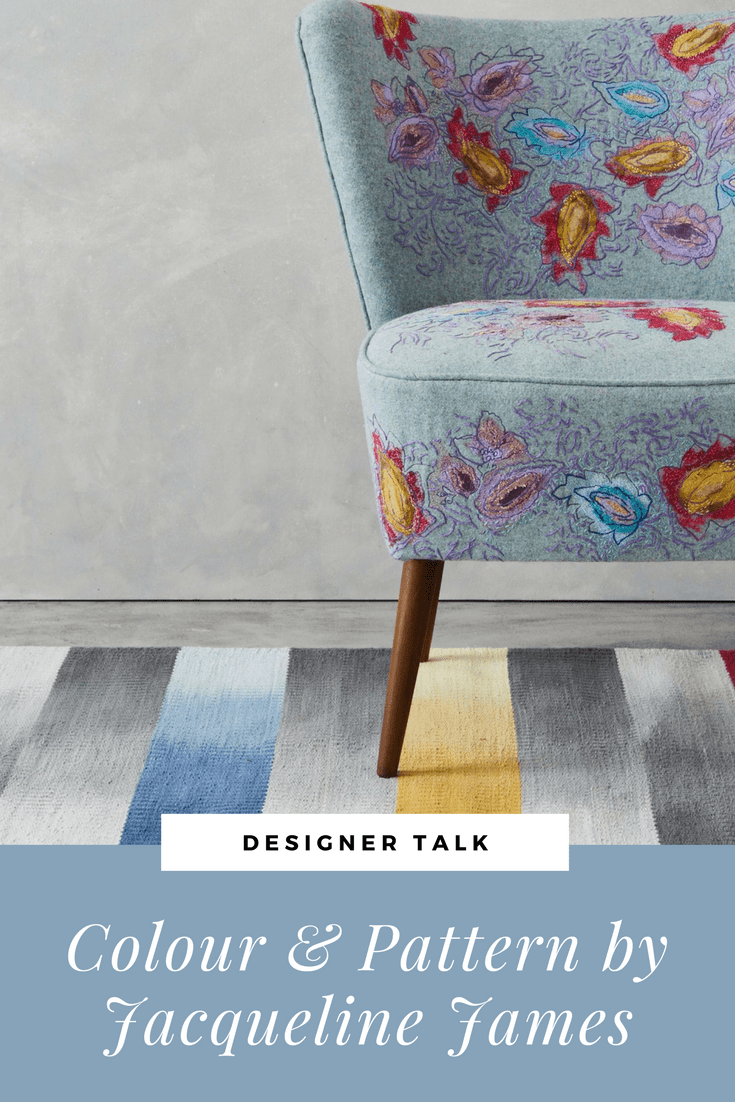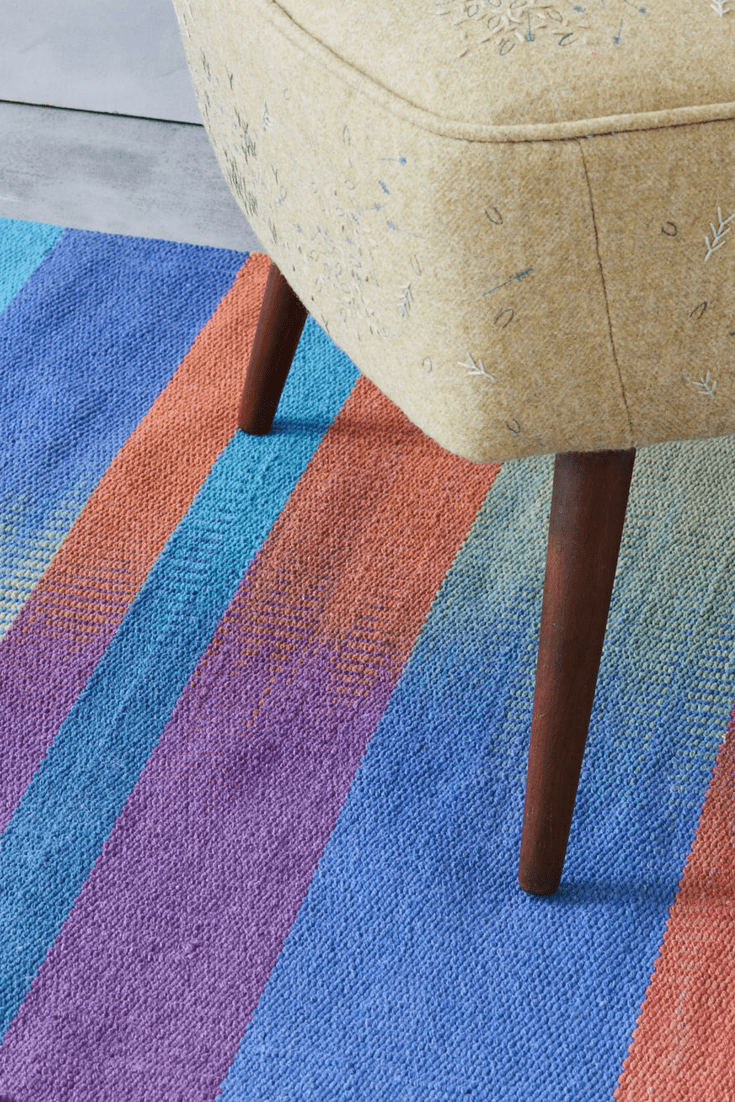Small Business Friday with Jacqueline James
- Jenny Kakoudakis

- Aug 11, 2017
- 6 min read

Last month I was looking at my new followers on Twitter - I always like to see what they tweet about so I can engage with them better - when I came across Jacqueline James, an experienced weaver who is passionate about her work and of course colour! I knew Jacqueline was very busy but I absolutely wanted to share her experience and work with you on the blog especially as handmade products are increasing in popularity in all homes.
With her work already in public and private collections in the UK and North America, Jacqueline James is the recipient of multiple awards and has had commissions for Westminster Abbey, York Minster and The British Library.
Weaving is labour intense. It is an craft that is seeing a revival with a number of textile designers branching into it. It is a slow process though and to create pieces like the ones you will see below you need to absolutely put your heart into it, just like Jacqueline.

Interview with Jacqueline James
Photography: Yeshen Venema
What first attracted you to weaving and were you influenced by your travels at a younger age ?
I was born in the UK but grew up on the North West coast, USA. From my earliest memories I have always enjoyed arts, crafts, being creative and making things with my hands. My interest in yarns, threads and textiles first began as a young child when my Granny, Mum, my sister Sally and Auntie Rena patiently taught me how to knit, crochet and sew.
I feel very fortunate that when I was ten my family traveled around Europe for a few months. We visited many incredible museums and art galleries which gave me a fundamental interest and appreciation of modern and classical art and architecture.
When I was growing up we lived near a university and I occasionally walked through the art department on my way home from school. I can clearly remember being excited and fascinated to see all the colourful threads and hear the rhythmic beat of the floor looms. I was enchanted. I did not imagine then that I would become a weaver, but I definitely knew I wanted to be an artist.
I had an excellent four year foundation in art during high school and experimented with many different art and craft mediums including painting, ceramics, batik and jewelry making, to name a few. This is where I completed my first basic woven tapestry on a wooden frame loom.
In 1982 I returned to the UK to live in the City of York. I attended a B-TEC course at Harrogate College of Art from 1985 to 1988 and focused on learning the skills of rug weaving. I have been running my business from my home studio since 1989 where I make individually designed hand-woven rugs and wall hangings for exhibition and often collaborate to create bespoke commissions for private clients, interior designers and architects.

Above: this is the Baines and Fricker SB01 plywood chair and a Jacqueline James wool rug.

Where do you draw your inspiration from?
I find inspiration all around me, everywhere I go. My wonderful art teachers and mentors taught me how to ‘see’. I am particularly attracted to striking patterns, unusual textures and beautiful colour combinations from nature.
Wherever I go I take photographs of landscapes and architectural elements that interest me and may possibly inspire future rug designs. I like to observe the subtle differences in light, shade and colours changing throughout the day and the seasons.
I admire and research many different weaving and dyeing techniques from around the World through books, magazines and the internet. I also regularly visit exhibitions and events that feature traditional and contemporary arts and crafts, especially textile related.

Above, a Zara Day embroidered chair.

What attracts you to geometric shapes specifically?
As well as colour, geometric shapes and stripe rhythms always catch my eye and inspire me. The rug weaving processes naturally create geometric patterns as the warp and weft are at right angles.
After an initial sketch I draw out my pattern on graph paper to get the correct proportions. I use traditional rug weaving techniques and sometimes use a method called ‘shaft switching’ with block weave which was invented by Master Weaver Peter Collingwood OBE. This enables me to change the threading of the grid pattern during the weaving process.


You work on a Swedish floor loom - what is special about it?
I have had my sturdy and faithful floor loom since I began my rug weaving career in 1989. I bought it second hand from one of my tutors at college. It even has special ‘loom boots’ to keep it stable and absorb some of the compression and noise.
The Glimakra floor loom is one of a few that can withstand the extreme demands of high tension from the tight linen warp and the constant weaving and hard beating action needed to achieve a good firm rug. I have grown very fond of my trusted loom as it has woven hundreds of rugs for me so far.
Your designs don't shy away from colour. What are your favourite colour combinations?
I love designing with colour, especially blues! Growing up I was surrounded by the stunning views of the Pacific Ocean and Cascade mountains which still influence my colour and design choices today. I like to work with warm and cool combinations, subtly graded hues and colours with a dash of the complimentary.
Bold use of colour and vibrant patterns are distinctive elements of my woven designs. I use a broad range of coloured wool yarns and blend several strands together, like mixing paint, to achieve the desired hues.
My recent rug collection is made with cotton weft threads that I carefully custom dye before the weaving process to get interesting design effects and colours.

You regularly undertake commissions. What is the most exciting project you have ever worked on?
Early in my career I was honoured to be invited to design and weave several commissions for two chapels at Westminster Abbey, London. In 1993 I designed and made an altar frontal for the Faith Chapel and in 1994 I created a triptych wall hanging and altar frontal for the Islip Chapel.
This was a very interesting and exciting opportunity for me as it was one of the first major commissions I had completed and improved my confidence and reputation as a professional weaver.
Do young people attend your workshops?
I used to regularly work as an artist in primary schools, but rarely do now since the introduction of the new, more academic, less creative curriculum. Now I occasionally run basic textile workshops with adults.
Whenever I get the opportunity I enjoy demonstrating weaving and teaching basic textile skills to people of all ages and hope to inspire future generations of weavers.
What is the longest you have ever worked on a single rug and why?
A few years ago I had a commission from a private client to weave a large striped rug for their dining room. In order to create the required width I had to weave two large identical pieces and join them together.
The commission would have normally taken around four weeks to complete, but actually took ten weeks as I encountered several challenges with accurate tension and measurements and had to re-weave one half of the rug three times to get it absolutely right. I am a perfectionist. Quality and attention to detail are essential to my weaving work.
What does your typical day look like?
I work most days in my home studio. In the morning I am usually sitting at my computer, drinking peppermint tea, reading and responding to emails and social media, doing general business administration tasks and marketing and promoting my hand-woven rugs.
The afternoons and evenings are spent on designing or weaving related activities like sketching, dyeing yarn, dressing the loom, winding shuttles and of course weaving.

When you are not weaving, what do you enjoy doing?
I enjoy walking in nature and spending quality time with family and friends. I am passionate about what I do and seem to spend much of my spare time reading about and researching weaving, textiles and other professional development topics.
My social life and spare time are usually associated with my weaving work. I really like learning new skills and experimenting to develop my weaving and dyeing work.
This year I have been doing lots of excellent and in depth online training with Patricia van den Akker from The Design Trust to help develop and grow my mid career business.
See all of Jacqueline's designs on her website. You can also connect with her on Twitter. Learn more about the Design Trust here. All the photos in this post are by The Designer/Maker's favourite photographer Yeshen Venema who has also worked with the likes of Giannina Capitani, Olivia J Holland, HOKOLO London and Thornback & Peel to name a few. The chair in the first photo is by Zara Day from the Memories Collection on Rosemary Rose.





